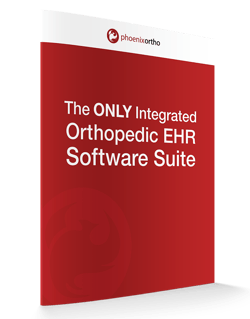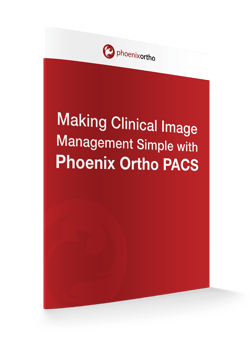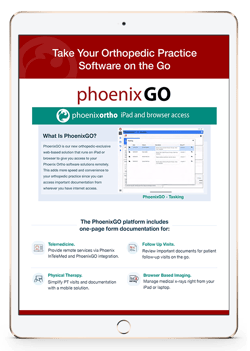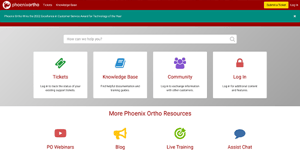The rise of virtual medicine has been a long time coming for the healthcare industry as a whole.
Even before the global pandemic, industry experts predicted that the global value of the telehealth market would grow to $19.5 billion by 2025.
The spread of COVID-19 and the public health safety mandates that encouraged fewer person-to-person interactions only served to accelerate the adoption of remote care solutions.
Let’s take a look at what virtual medicine is, why modern orthopedic clinics need it, and how you can integrate it into your clinical workflows:
What Is Virtual Medicine?
Virtual medicine is the term for delivering healthcare services remotely to patients via tools like phone or video conferencing. It may often be conflated with telemedicine, but virtual medicine has a broader scope than just the ability to see patients remotely.
Telemedicine might enable virtual visits, but it is only one of the tools used in virtual medicine workflows.
The concept of virtual medicine can include remotely:
- Communicating with patients live via teleconferencing solutions, text messages, or phone conversations
- Prescribing medications
- Reviewing patient health histories and other information
Of course, not every need can be served remotely. There will be situations where an orthopedic surgeon will need to see a patient in person to provide the best quality of care or to perform specific procedures.
Despite this, virtual medicine is rapidly becoming a business necessity for orthopedic clinics.
Why Is Virtual Medicine a Necessity for Modern Orthopedic Practice?
So, why do modern orthopedic clinics need to be able to conduct remote visits using telehealth technology?
There are a number of reasons, such as:
1. Expanding the Service Area for the Clinic
Convenience is a major limiting factor for many businesses—including orthopedic clinics. The distance that patients are willing to travel for routine care is often limited. For example, many adults are willing to travel about 20.4 miles or drive for 28.4 minutes for routine care and will travel for 22 miles or drive for 30 minutes on average for emergency care (Source: Washington State Health Services).
The issue is that orthopedic practices located further away than people are willing to drive may lose out on being able to service those patients’ needs unless they’re the only choice in the area.
According to some sources, there are currently more than 30,500 orthopedic surgeons operating in the USA. Because of their distribution throughout the country, highly-populated cities are more likely to have multiple orthopedic surgeons operating in them at the same time, whereas smaller towns may be home to only one or none at all.
By offering telehealth services such as virtual visits, orthopedic clinics can extend their range to capture new customers.
2. Standing out from the Competition
Being the most convenient option and having tools that let people seek your services easily can be a major differentiating factor for getting patients to choose your medical practice.
While referrals from primary care physicians remains a key strategy for getting new business, some patients may prefer to “shop around” for non-emergency care to find the most convenient and economical choice.
Your clinic’s ability to deliver remote services using virtual visits and other technologies can be an enormous differentiating factor. It removes one of the biggest barriers to seeking non-urgent care (having to look up a doctor’s office and drive there) so that the patient can get orthopedic advice immediately.
If you compare a clinic that can provide simple information and advice remotely with one that requires a walk-in for every interaction, it’s easy to see which one would be preferred by consumers.
3. Potentially Improving Patient Satisfaction
Patient satisfaction is an enormous factor in determining whether patients return to the same clinic for their orthopedic care. Traditional, in-office services are vulnerable to a variety of factors that can negatively impact satisfaction for patients.
For example, clinic workflow bottlenecks can be frustrating—especially for patients who show up on time for an appointment only to be told that they have to wait for their orthopedic surgeon to be available.
By leveraging virtual visits and telemedicine solutions, orthopedic clinics can eliminate the need for patients to sit and wait in their clinic for basic consultative services. This increases convenience and patient satisfaction.
4. Meeting Patient Expectations
In a report by the Medical Group Management Association (MGMA), it was noted that “the use of telehealth is 38 times higher than it was before the COVID-19 pandemic.” MGMA also reported that 40% of medical practice leaders they polled expected telehealth use to remain about the same, and a further 30% expected it to increase in the coming years.
Modern consumers are becoming increasingly used to instant gratification and getting services through their phones or other mobile devices. So, it makes sense that many leaders in the wider healthcare industry anticipate the demand for remote visit services to either remain high or grow over the next few years.
Clinics that are not able to meet consumer demand for virtual services may find themselves at a disadvantage against those clinics that do offer such services—increasing the risk of losing patients to more technologically-savvy competitors.
Integrate a Telemedicine Solution Today!
Are you ready to transform the way that your clinic processes patients for non-urgent orthopedic care? Reach out to Phoenix Ortho and request a demo of our InTeleMed solution now!
With Phoenix InTeleMed and our orthopedic-exclusive Electronic Health Record (EHR) software suite, you can not only enable virtual visits in your clinic, you can cut down time spent on paperwork, reduce labor for common clinical workflows, and improve collections by optimizing your evaluation and management (E & M) coding process.
Schedule a 1:1
Get in touch with Phoenix Ortho to learn more about how you can save time, money, and mouse clicks with an orthopedic-specific EHR.






















